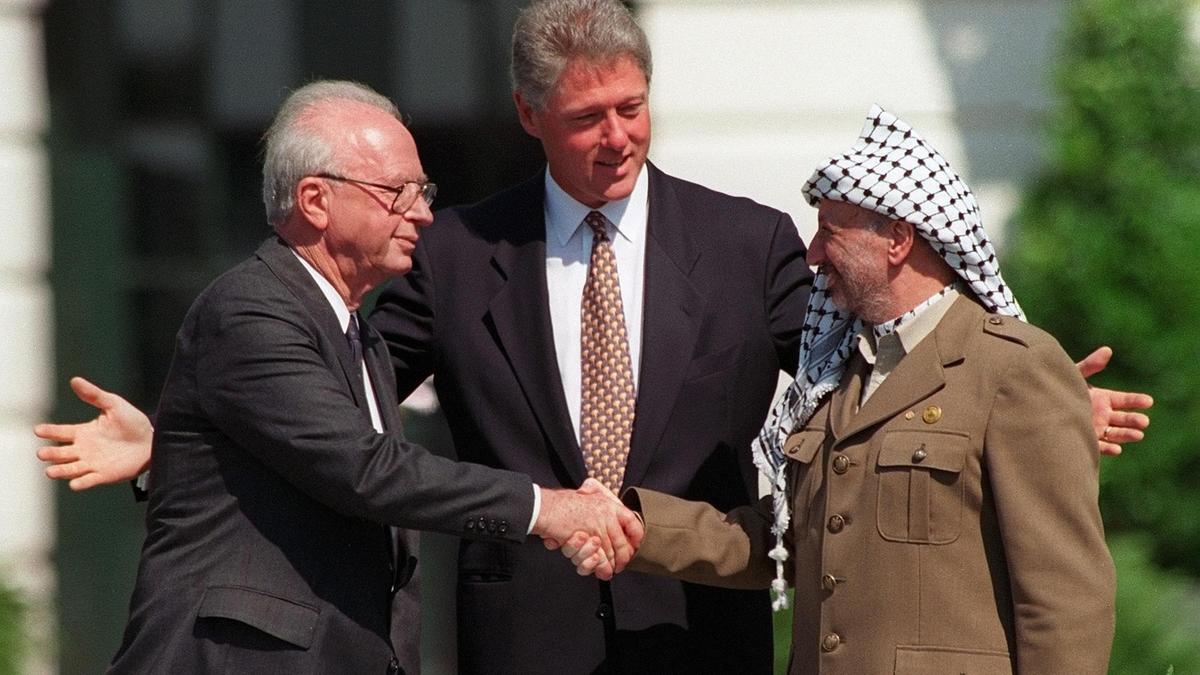The Oslo Accord: 25 Years On

by Hugo Jones
The picture of Bill Clinton standing between Yasser Arafat and Yitzhak Rabin on the Whitehouse lawn in 1993 captures the zeitgeist of hope unique to that period in history. Twenty-five years later, ‘Oslo’ is a dirty word in the occupied territories, and many look back at the photo in ridicule. An invisible ‘Mission Accomplished’ banner flutters in the background. Of the three defenders of hope pictured, Rabin was assassinated by right-wing extremists in 1995. Arafat died in Israeli detention in 2004 as another Intifada raged through the occupied territories. And most recently, the Clintons found themselves ushering in an American President that scorns the institutions that made Oslo possible.
Since the Oslo accords, around 600,000 Israeli settlers have illegally moved into East Jerusalem and the West Bank. The number of Palestinian refugees has risen to over five million, two million of whom live in United Nations Relief and Works Agency (UNRWA) refugee camps - the very same UNRWA that recently lost half of its funding from its main donor, the USA. These refugees are stateless – and yet the 1993 accords were intended to create an autonomous state to function as a home for the Palestinians. How did Oslo fail so spectacularly?
The actors that Oslo envisaged bringing stability to the region proved unreliable, corrupting in nature and ambition. Today, the Palestinian Authority (PA) is in the eyes of many Palestinians little more than an instrument of Israel: a ‘sub-sovereign Palestinian Authority to help manage the occupation’. In addition, we have witnessed a change in the political elite of Israel, as liberals such as Rabin gave way to right-wing militarist figures such as Ariel Sharon and Benjamin Netenyahu. Oslo II, in 1995, was both the start and the end of the peace process; as a result, the carving up of the West Bank into areas under either PA or Israeli authority pushed the prospect of a peaceful solution further away, as these areas were intended to be temporary arrangements.
The solution proposed was one of gradualism, a process that was halted and abused to facilitate the settlement programme and economic dependency of the Occupied Territories. The flaws in the Oslo accords were recognised by Edward Said in 1993, as he stated that ‘with its well-developed institutions, close relations with the US and aggressive economy, Israel will in effect incorporate the territories economically, keeping them in a state of permanent dependency.’ Said writes in the same article: ‘the Palestinians, after all, have very little left to give.’ With East Jerusalem effectively ‘ceded’ to Israel by Trump, in 2018 what indeed do the Palestinians have left?
Israel-Palestine relations stand out as a human rights issue, as they are inherently a global issue. International actors have shaped the region and those who call it ‘home’ depend on them. The outcome of a peace process, or lack thereof, is something that the international community must be responsible for. As governments and multinational organisations fail to address a worsening situation in Israel and Palestine, increasingly the responsibility to act seems to have been transferred to the individual.
Boycott, Divest and Sanction (BDS) is one way in which individuals are taking action. Also, Maen Hammad recently recounted his experiences as a Palestinian growing up in the shadow of the Oslo accords, in a short piece for TIME magazine.
